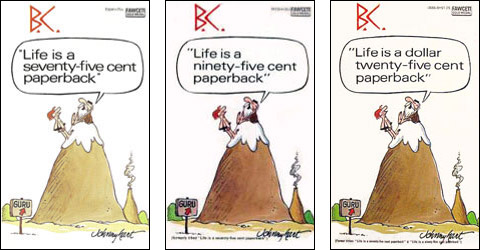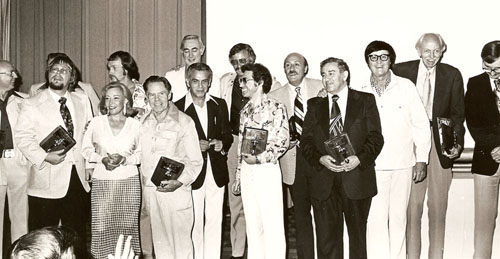
Yesterday in this post, I gave you a photo taken at the Inkpot Awards Ceremony at the 1975 San Diego Comic-Con. Back then, the awards ceremony consisted only of the Inkpot Awards, which were bestowed by the convention committee. Later on, they added in the Eisner Awards and eventually, the Eisners squeezed the Inkpots out of their own ceremony. The Inkpots are now presented at daytime panels and other events. Also, in case anyone's puzzled about this: The Comic-Con International used to be called the San Diego Comic-Con, among other names.
Yesterday's photo was interesting because one rarely sees so many important, creative people in one snapshot and I was able to identify all but two of them. One, we've subsequently fingered as Jim Starlin…but there's another person in the photo whose face is blocked from the photographer's angle by Richard Butner, the convention chairperson. That's Richard you see with the beard in the above detail from the photo. A lot of my correspondents are now trying to guess who that person is behind Richard.
Many of them tried to guess by looking at the list of that year's Inkpot recipients. That year, the convention presented them to a couple of the convention committee members…but I can recognize all those people and I'm pretty sure it's not them. There were also Inkpots presented posthumously…to Vaughn Bode, Edgar Rice Burroughs, Rod Serling and Larry "Seymour" Vincent. It's none of them, obviously. (Larry Vincent was a great horror movie host, by the way. Here's an article I wrote about him.)
The professional recipients in '75 were Brad Anderson, Robert Bloch, Daws Butler, Will Eisner, me, Gil Kane, Dick Moores, George Pal, Joe Shuster, Jerry Siegel, Barry Windsor-Smith, Jim Starlin, Jim Steranko and Theodore Sturgeon…and no, I don't know what I was doing in a list like that, either. I think someone had been watching them play "One of these things is not like the others" on Sesame Street. We've already identified Anderson, Butler, Eisner, Kane, Moores, Siegel, Starlin and Steranko in the photo so it's none of them. I don't think George Pal or Barry Windsor-Smith were at the convention. Windsor-Smith might have been but anyway, it doesn't look like him. It also doesn't look like Shuster or Sturgeon.
It's not me. I'm taller than that and never had hair or a jacket like that and anyway, I didn't go to the award ceremony that year because I found out in advance that I was getting one. (They were badly-kept secrets back then. I think Alberto Gonzales's staff was in charge of security.) Anyway, I'll tell you some time why I didn't attend but for now, you just need to know it isn't me.
I thought it could be Robert Bloch, the author of Psycho, among other works…and I'm not 100% certain it isn't. But then Bob Foster sent me an e-mail and he's sure it's Russ Manning. I'm not positive but that's a much better guess. True, Manning didn't win an Inkpot that year but then neither did Jack Kirby, Stan Lee, Bob Clampett and June Foray, all of whom are in the photo. All of them, like Russ, received Inkpots in 1974, which was the first year of those awards. I think in '75, the convention got all the past winners who were present up there to pose with the new recipients and I'm pretty sure Russ was present. In fact, I believe he accepted the Inkpot for Edgar Rice Burroughs. Russ was then drawing the Tarzan newspaper strip.
So in the absence of more or better evidence, I'll say it's Russ Manning. Anyone got a better deduction? If it's Russ and if you could see that, it would make the photo even more impressive.



